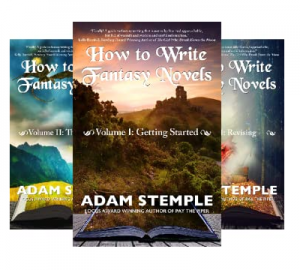I write fantasy fiction. That means that when I write, I have to make a lot of shit up. And the shit I make up has to be as real to the reader as the world they live in.
This is not easy.
Luckily, the reader is (usually) on my side. They want to believe. And I want to help them. One of the ways I try to do this is actually something I learned through writing songs. I call it resonance.
Songs are (generally) a condensed form of writing. You don’t have a lot of words to get your message/emotion/story across, so you must pick them with the utmost care. Luckily, words are multi-use creatures. They resonate with more than just their pure, unadorned meaning. They carry this extra weight with them when they cross the ear or eye and enter the brain, triggering emotion, imagery, memory, and more. Writing songs taught me to harness that resonance, creating emotional subtext to the piece on top of what the music—an emotion-making machine in its own right—brings.
When writing fantasy—especially secondary world fantasy—one of the most difficult task for a writer is recreating that resonance in the terms that they have made up.
The resonance of known words is built on a reader’s long association with the words and their multiple meanings and varied emotional messages. To create that in made up words—and worlds—a writer has to somehow fabricate that depth and impart it to the reader.
In made up worlds, fabricating the depth can be the easy part. I try to know the history of the world I’m writing in as deeply as possible. I draw maps and timelines. I write histories, myths, create pantheons of gods. I study real world cultures and try to discern not just how they function, but how that functionality came to be. You can describe a setting and relate a scene, but if you don’t understand the underpinning of it all, it can end up thin. This almost impercievable thinness can still leech the engagement from your reader.
Imparting that knowledge to the reader is a difficult dance. Give too much and you risk boring them with info dumps and expository lumps. Give to little and you risk the leeching mentioned above. Let Hemingway’s iceberg principle be your guide: “The dignity of movement of an iceberg is due to only one-eighth of it being above water.” You don’t need to show everything you know to create resonance.
But how does that work? If you don’t tell the reader the things you know, what use is it?
When you understand the history of your characters and the world they move in, everything they do will follow that internal logic. And the reader can sense that. You don’t need to over-explain it.
Single words and terms are a much harder sell than whole worlds as far as resonance is concerned.
First off, don’t make it harder for yourself than you have to. Writer James Blish said that if it has long ears, buck teeth, and a fluffy tail, call it a rabbit, not a smeerp. The word rabbit has resonance. It doesn’t need to be created. The same goes for a troll or a dragon or other mythical monsters. Though they are made up themselves, they have accrued the resonance of long use. If you have a flying lizard that breathes fire, not calling it a dragon seems disingenuous.
But if that’s not the resonance you’re going for, it’s essential to give it a new name. Don’t just throw a bunch of Ks and a couple of apostrophes onto the page. Dig into it. Develop a history of the language behind the word and the people who speak it? Will there be other terms in your book in this language? Then they should share some qualities, qualities that will be different from any other cultures/languages in your tale. When you begin to build a language and a history for your words, you begin to impart that resonance. Even if it’s not there in the beginning, it can grow during the reading. For a master’s class on language becoming resonant as the book progresses, read A Clockwork Orange, though I’ll give a trigger warning for nearly everything within it.
The impartation of this resonance is even more delicate, as no one stops in the middle of a conversation to give a dissertation on the etymology of a word they just used. But again, knowing that etymology gives all the language you invent to describe your world an internal logic that is sensed by the reader. Begin a glossary. Build new words based on the old ones. Edit them till they behave like a real language, or at least an approximation of one.
Do the same with character names. What culture is the character from? What social class? I like to do my own version of iatrogenic labeling with my characters where their names affect their nature and vice versa. Usually in the meaning of the name, but sometimes more directly with nicknames and the like. This can help to add resonance and also keep the reader from forgetting the names of characters.
Heron.
Pit.
Mick the Jew.
Mika Bare-Hand.
Heelshod Jod.
Humps.
Tinker.
Tollo.
Ase.
Martes.
Aine.
Egil ba Egil.
Major and minor characters all get thought put into their names. Not necessarily during the first draft, but no character gets named haphazardly. Hopefully, that extra bit of resonance makes the reader care even for the least characters in my books. Emotional attachment equals reader engagement. And as I’ve said before, writing is a collaborative act; a book isn’t finished until it’s read.
If this seems like a lot of work for stuff that never sees the page, it is. But it’s worth it.
For more tips on writing, check out my series, How to Write Fantasy Novels, in eBook or paperback.

